Fixing Banjo Timing - Banjo Tab Exercises
The key to learning and mastering the basics of Banjo Timing is simply, learning to count. I played in the marching band in school and we learned to count. I like most people was all over the place but a few sharp drum stick hits and a band leader waving a baton counting out loud taught me rhythm and how to count.
As a banjo teacher I specialize in helping students of all ages but mostly adults learn to do something that they always wanted to do, and that's play banjo. One of the first apprehensions I often hear from new students or from students fearful in their own ability to learn the banjo is. "I've got no rhythm". Well, I am here to reassure you that rhythm and counting can be taught and learned, and its way more simple than you might think. In fact simple is the key. It comes down to learning to count beats and count in complete measures. Next is a simple tool that is so under utilized in banjo practice that it frankly makes me grouchy, and that is the metronome. I've seen students that would do most anything to be a good banjo player do almost anything to avoid using a metronome. I am here to remind you, if you want to be a banjo player, have other musicians enjoy playing with you.. and like you, or have people want to hear you play, learn to use it. Because of our steady heart beat there isn't a human in the world that cannot sense when the beat is off, nor one that can't learn to count time. We all have the best metronome ever assembled in our chest.
Now if avoiding a metronome is you, don't feel bad, lots of pros and great players had to back up and rescue the runaway train. They likely started working hard at it when they fully realized it's importance or that it was holding them back from being the best they could be.
The key to learning to use a metronome is to start simple and count with it, WITHOUT PLAYING YOUR BANJO. One thing at a time. A common mistake is trying to learn to use a metronome while learning a new song or playing a song you are not proficient enough at to fully focus on learning the metronome or timing.
The banjo unlike a trumpet or violin is like a drum and cannot sustain a note more than 1/4 beat. SO... the good news is we only need to concern ourselves with 1/4 and 1/8 beats. So that narrows it down to clearly and definitively learning how to count 1/4 and 1/8 beats. Once we are solid on that we can build and perfect from there. Solid is not simply understanding it, its counting out loud, practicing with or without a metronome and repetition to lock it in.
Because of the lack of sustain we will always have four 1/4 or "down" beats in 4/4 time. The vast majority of bluegrass songs we learn on the banjo are in 4/4 time. 4/4 = four 1/4 beats per measure. Its how many 1/8 beats there are mixed in to the 4 beat measures that is variable. What we want to get really tight at is how to count out and play the many possible combinations of 1/4 and 1/8 notes in a measure that equal four 1/4 beats.
Note: If you see a song in 2/4 time or hear a banjo teacher referring to 1/8 and 1/16 notes, the same way I am referring to 1/4 and 1/8 notes let me clarify that. 2/4 time can also be called "Cut time" and is still counted the same way as 4/4 time, its just split in half. In 2/4 there are two beats per measure which means 8 1/16 notes can fit into one measure of 2/4 cut time or only two 1/4 beats and four 1/8 beats, but the distance relationship between the beats is the same. In layman's terms, it's apples to oranges for our purpose.
Timing Exercises
You can do these exercises WITH or WITHOUT a metronome. If you have never used a metronome or not had much success with it, start without it, so you can focus on one thing at a time.
1. Using the 1st measure ONLY in the banjo tab below: For each 1/4 note (or 1/4 beat), Tap Your Foot, and as your foot comes down, say out loud the word "Down"
Those are the Down Beats. There are four 1/4 or "down beats" in this measure.
Practice ONLY the first measure at least 5 consecutive times and say the word "Down" like you mean it.
2. Next, Using the 2nd measure ONLY, This time add the word "Up" as your foot comes UP for every note BETWEEN the down beats. Those are the "UP" beats.
Do that at least 5 times. Once is not enough if you want to get the hang of this or improve.
This is not mental memory, its muscle memory, its learning to do something instinctively by repeating it over and over so you can do it without thinking about it. For instance later, when you need to focus on a difficult passage learning a song these simple timing repetitions and counting exercises will have ingrained the beat in you so you can move on to other more complicated things.
3. Next is key, in the next two examples you will be mixing 1/4 notes and 1/8 notes and saying out loud Down and Up for each down or up beat. Practice these a bunch WITHOUT YOUR BANJO and speak out loud like you mean it.
4. In measures 5 6 7 and 8. Replace the words DOWN and UP with the words CLICK or CLICK AND
If you have a metronome this is the perfect way to learn to use it by saying the word CLICK for the down beat or when the metronome Clicks) and saying the word AND for the 1/8 note Up beats between the clicks.
5. The last four measures are the more traditional way of counting with numbers. These are done exactly the same way with 1 2 3 and 4 being the "DOWN" beats and the + signs are the "UP" beats.
Count out all of these exercises out loud, with conviction, for as long as you can stand it, and it will stick like glue. There is nothing to be ashamed about in simplicity. It is what builds a strong foundation. 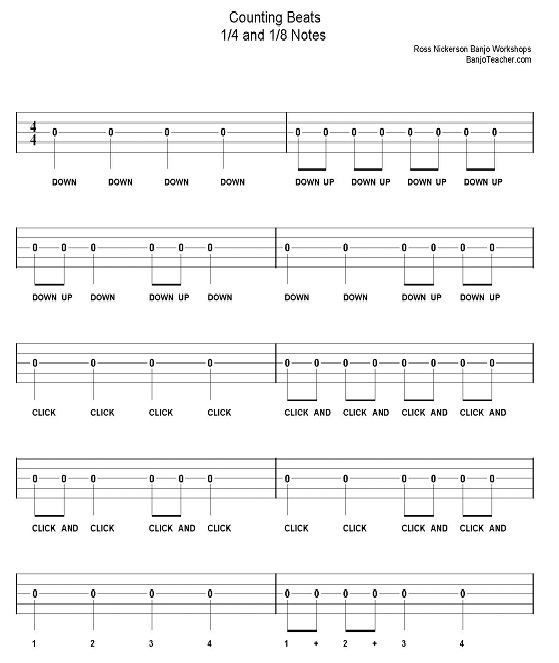
Here is another timing exercises example. Again I kept the playing part super simple so you can focus on counting with authority and feeling the rhythmic differentiation between 1/4 and 1/8 beats.
The only thing that may be new or feel unusual depending on your experience level is you may not have used your thumb on the 1st string before or used your thumb on the 2nd string the way it is in this exercise. The use of the thumb on the 2nd string is consistent with Scruggs Style. Remember in Scruggs Style you use the thumb to play the melody and the thumb often plays the 2nd string as long as you have not used the thumb on an 1/8 note, just prior to needing to pick the 2nd string. There are exceptions to any technique but don't let the index finger drive the bus in Scruggs Style. The thumb leads the way. Read an article I have on playing the melody and how to choose the best finger option to play the melody with. Playing The Melody on a Banjo - Using the Thumb
Thanks, Ross
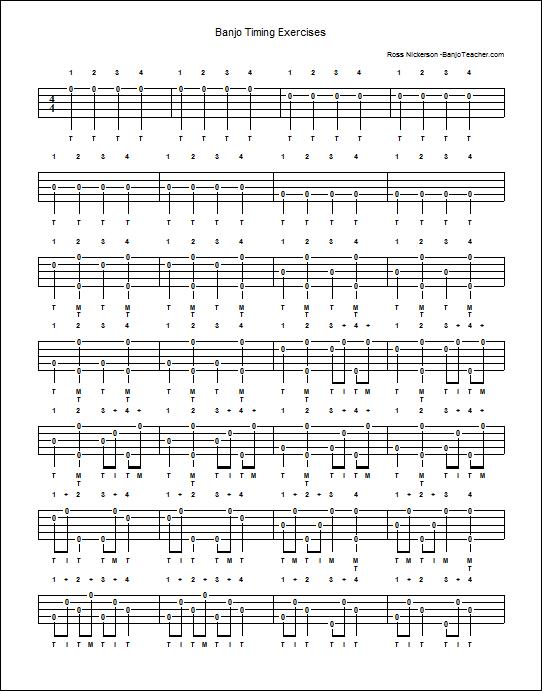
Books/DVDs by Ross Nickerson to Help with your Timing
Discounts and Free Shipping AUTOMATICALLY
when ordering more than one Book, CD or DVD DISCOUNTS AND FREE SHIPPING



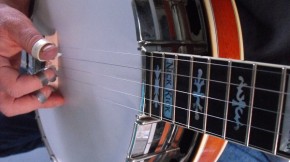
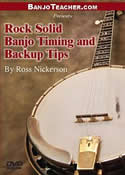
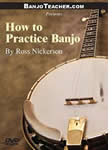
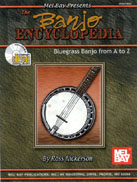







Ma**** ****er 03/20/2018
Excellent article on timing!!! This is a huge issue for many banjo students. Thanks for breaking it down and providing useful exercises.Martha